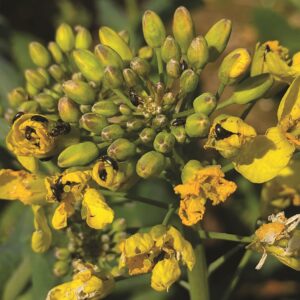New pests on the horizon
Click here to find the full article.
What’s the biggest yield robber on your farm? Sometimes growing canola seems like a big game of whack a mole. Plan to better manage flea beetles, and herbicide-resistant kochia takes off. Growing a clubroot resistant variety is great, but doesn’t solve a sclerotinia or grasshopper problem. The list of pests to scout for in canola only seems to grow. We have thresholds, best management practices (BMPs) and a litany of scientific research guiding us to make the best possible recommendations. The harder question to answer is what will be the biggest yield robber in years to come? In the future, climate change will impact canola yield and quality, directly through abiotic stress and indirectly by impacting pest behaviour, distribution and survivability. Understanding current and potential biotic production threats is essential for the Canadian canola industry to remain sustainable and profitable.
More favourable overwintering conditions could increase the survival of existing or newly introduced insects.
As a part of an effort to better prepare for the future, the Canola Council of Canada staff recently published a paper looking at the future of pests we already see on the Prairies and pests identified in other canola growing regions around the world. The paper, “Current and potential pest threats for canola in the Canadian Prairies,” was published in Pest Management Science, October 2023. Here are a few highlights:
Insects
The cool climate of Western Canada mean the Prairie provinces have a somewhat reduced collection of problematic insect pests in comparison with other regions of the world. More favourable overwintering conditions could increase the survival of existing or newly introduced insects. Insect pests may also begin their life cycle and feeding earlier in the growing season because of warmer spring temperatures.

Swede midge currently causes damage to canola in Eastern Canada. The predicted adaptation of swede midge across the Canadian Prairies, should it be introduced, is dependent on climate. Misidentification of swede midge in the Prairies from 2012 to 2019 has been attributed to a newly discovered species, Contarinia brassicola, which does not seem to cause significant yield loss. Common pollen beetle, and bronzed pollen beetle, are considered invasive pest species for Canadian canola production. Bronzed pollen beetle is present in Eastern Canada, but has not established in Western Canada. Successful introduction of the pollen beetle has the potential to be very detrimental to Prairie canola production because of the damage larvae can do to flower buds. To mitigate risk, researchers are examining established populations in Eastern Canada to check on the pest’s biology and control.
Plant pathogens
Plant pathogens that cause disease are significant threats to canola production in Canada. Changing environmental conditions, adapting plant pathogens and an increase in canola seeded area have resulted in significant yield losses. Established diseases like blackleg and clubroot continue to evolve, while newer diseases like verticillium stripe, first discovered in 2014, continue to spread.
Verticillium stripe is a soil-borne disease that prefers warmer soil temperatures to accelerate its spread into stem vascular tissue and its characteristic striping. The pathogen latency period, influenced by temperature, can impact disease expression and population aggressiveness. Research is needed to better understand the spread and severity of verticillium stripe within Canada, along with how to best manage the disease under changing climate conditions.
Weeds
Herbicide-resistant canola was introduced into Western Canada in 1996 and weed control was simplified. Fast forward to today. Despite improved weed control and more flexible application timing, weed populations remain a constant yield threat in canola. The threat of weeds can be divided into two classes, those emerging from herbicide resistance and those newly introduced into a region.
Herbicide resistance is well documented and has increase tenfold from 2001 to 2017. Kochia resistant to many modes of action, including glyphosate, continues to rapidly spread through the Prairies. Wild oat is already resistant to several modes of action, which puts additional selection pressure on glyphosate. Should wild oats develop resistance to glyphosate this would require a foundational change in how we produce canola.




